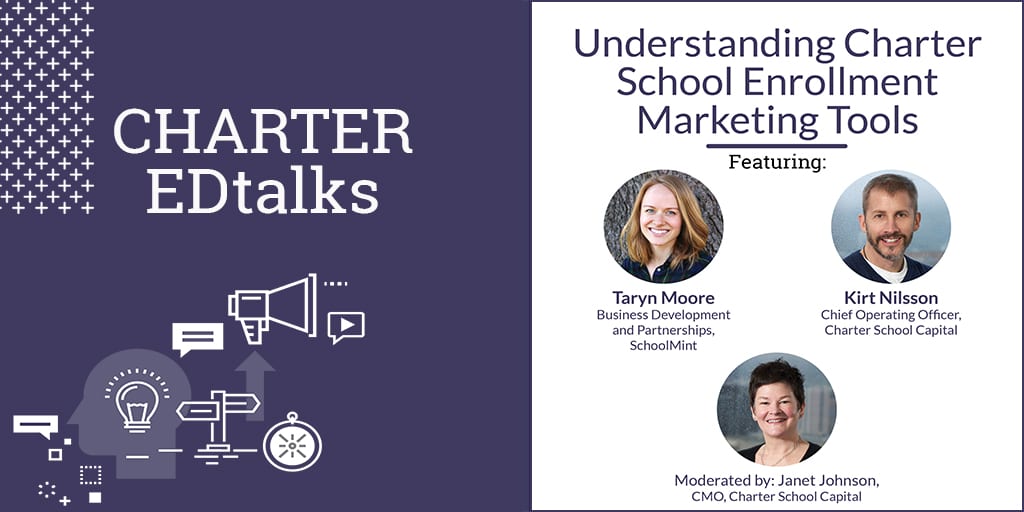 Understanding Charter School Enrollment Marketing Tools
Understanding Charter School Enrollment Marketing Tools
Editor’s Note: In this, the proverbial age of technology, we wanted to dive deeper into how technology tools could specifically help with charter school enrollment marketing. For this CHARTER EDtalk, we were honored to be joined by Taryn Moore in Business Development and Partnerships at SchoolMint. SchoolMint has years of experience working with charter schools — from single-site schools to large charter management organizations (CMOs). They understand your environment and can help optimize your system for your requirements and your recruitment, application, lottery, and registration processes.
We think it’s vital to keep tabs on the pulse of all things related to charter schools, including informational resources, and how to support charter school growth. We hope you find this—and any other blog post we write—both interesting and valuable. Below you will find the video and the transcript. Please read on to learn more.
Janet Johnson (JJ): Good morning. I’m Janet Johnson with Charter School Capital. We’re here with Taryn Moore from SchoolMint and Kirt Nilsson from Charter School Capital, talking about enrollment today. Thanks for joining us.
Taryn Moore (TM): Thank you for having me.
Kirt Nilsson (KN): School enrollment—when it comes to schools thinking of that, it can be a little daunting. They have to run their schools and also try and get their word out. When it comes to things like leads and lotteries, can you think of ways they can manage that kind of information and that kind of process?
TM: Sure. There are so many great tools out there. I think the key is really finding the tool that’s right for you. I would say look to your current challenges. If you have a lottery that families are saying is not transparent, find an automated lottery tool. Something that really directly addresses that challenge. First and foremost, I would say with whatever tool you choose, find one that’s suitable for your families. If your families don’t have home computers, necessarily, find a tool that’s accessible on mobile, or find a tool that’s available in multiple languages. The goal is to make it easier and more accessible for families.
KN: You talked about some of the tools that are right for the school. Does it matter if they’re a school that’s just getting started, or they’re one that’s been around for several years and have been renewed … is there a right time for a school to start accessing technology like that?
TM: I would say as early as possible is really the best time to start. I think, when you start early, you can tackle some of those change-management hurdles early on and start reaping the benefits sooner. And you can start out light-weight. Start out with a online application. Then, when it makes sense, move into a lottery or a lead tracking system.
KN: I can definitely hear some of the reasons why a school would want to access technology like that. Are there also benefits to the families and the students from schools that access technology? If so, what comes to mind?
TM: I think, for families, bringing technology into the mix really makes things more simple, more accessible to them. It can make really confusing policies feel simpler. It can bring a lot of transparency to various processes as well. Like I was saying before, if you have a tool that’s accessible on mobile, a tool that’s available in a language that’s comfortable for you, that’s going to do wonders for families.
KN: Fantastic. Broadly, if you were to take your experience and say, “Hey, over the last couple of years things are changing in the enrollment technology space,” what kind of things are you seeing? What kind of things should schools be aware of as they think about this?
TM: I think we’re seeing a lot of different trends. One is a move toward common applications. We’re seeing more and more cities unified – bringing all of their charter schools, or a subset of those schools, together onto a common timeline and into a single application – so parents only go to one place to put that application in. We’re also seeing a lot more sophistication in interest tracking and events tracking so that schools can manage, track, and engage prospective families.
The last thing I would say, we’re seeing a lot more sophistication in the way of data analysis. Schools want to know where their student applicants are coming from. And schools want to see what their acceptance rates are like year over year.
Also, on the front of data analysis, when you think about something simple, like a student address. We’re all collecting student addresses on a paper form. You can’t do much with it; it’s just on paper. If you have an online tool that takes that student address and drops a pin at that student’s home location, then you have this beautiful visualization of a map. You can see there’s this cluster of students in this area, and there’s kind of this bare spot over here. Then, you can make really data-driven decisions about outreach, to help achieve your enrollment goals.
JJ: That’s great.
KN: When I listen, I’m like, “She’s really offering great information.” But if I’m the school, and I hear all that, I’m like, “Wow, that sounds a little daunting.” Why shouldn’t I be worried about taking the first step to move in this direction, if I’m a school?
TM: Everybody’s got to start somewhere, and there’s definitely some change management involved in the move to technology, but there are some benefits right off the top. I think, particularly for school staff. If you think about admins, who are today, spending lots of time entering data from paper systems. The move to online makes them really have a simpler day to day experience in the office. If they’re not entering that data from paper systems, if they’re not spending time manually tracking and managing a wait list, for example; they have more time to spend directly with families, which is really a better use of their time anyway. Of course, they have so much more powerful data to deal with as well.
KN: As we listen to you and start to get comfortable with the idea of using that technology to really move forward enrollment in schools, what kind of things do you see that come from it? What’s the success story that comes from using this kind of technology?
TM: I think some of the points that we’ve hit on already. An easier, more transparent experience for families, for sure. More powerful access to data for schools, so that they can really make data-driven decisions, and really move into the 21st Century. Parents are already using so many online tools as it is, to check student’s grades, to get e-newsletters from schools. To bring more and more of those processes online. I think it’s a lot less daunting today than it was even just five years ago.
KN: As you mentioned the different systems, and how schools are coming up to speed, do enrollment technology systems integrate with other systems of the school? Do they even need to?
TM: Yes, absolutely. We see it both ways. We see a lot of schools where they have a bunch of ad hoc systems that are working independently, and they’re navigating through those. We use those every day on our phones. If you open up your phone, you’ve got a whole slew of different apps that don’t have anything to do with each other. We somehow find a use for all of them and a way to navigate through them. Then there are also systems that are really end-to-end, so there’s not a need to integrate with other systems because they really cover a whole range of processes. Then, of course, there are systems that have great partnerships, or maybe there’s a platform of systems that really integrate seamlessly.
KN: It sounds like a lot of choices out there. If I’m a school, and I’m thinking through the choices, how do I take the first step? What’s the first thing that I should do?
TM: I think, in terms of making the choice, a simple Google search, of course, will render a lot of great results. I think also just talking to school admins and school leaders in your area can be a really helpful starting point. So many tools exist, and many of them are already in use by schools today. Finding out what others’ experiences have been like, I think, can be really helpful. Even thinking beyond just the horizons of your immediate geographic area, reaching out to school leaders in other areas of the country that maybe have similar challenges as you or similar demographics, can be really, really helpful. Kind of finding out what it’s like to work with a particular technology provider or a particular system.
KN: Now is the time of year, when schools have finished, and they’re all giddy that the school year is over; but the fall is not that far away. Are they too late to start thinking about these technologies, or using them? Are they too late, if they get started now, for the fall?
TM: I think it depends on the system that you’re looking for, the issue that you’re looking to address. I think if you’re looking to an online application system, for example, a lot of those systems can get you up and running in a matter of a couple of weeks, or maybe a month. I think it’s definitely not too late. It’s certainly never too late to at least begin exploring what your options are.
KN: It sounds like that’s the message. It’s not too late. There are a lot of benefits of enrollment marketing tools to charter schools. A lot of benefits to parents. So get it going.
TM: Yes, absolutely.
JJ: All right. Thank you, Taryn, so much.
Feel free to email Taryn (taryn@schoolmint.net) with any questions you may have about your charter school enrollment needs.
 Digital Marketing for Charter Schools: An Actionable Workbook to Help You Achieve Your School’s Goals!
Digital Marketing for Charter Schools: An Actionable Workbook to Help You Achieve Your School’s Goals!
Need strategic tips on enrollment marketing for your charter school? Scratching your head as to how to go about implementing digital marketing? You’re not alone! This free manual will be your go-to guide for all of your school’s digital marketing needs! Download this actionable workbook to help get your marketing plans started, guide you as you define your audience and key differentiators, choose your tactics, and start to build your campaigns.